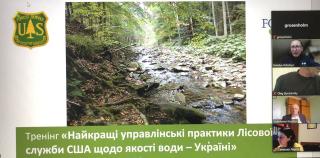Forest Service webinar series helps Ukraine

NEW YORK—The USDA Forest Service, New York Watershed Agricultural Council and Agency for Sustainable Development of Carpathian Region, or FORZA, delivered forestry best management practices training to Ukrainian foresters and engineers. The webinar series taught them to protect their water quality during timber operations. About 50-70 Ukrainian foresters attended each webinar, which were conducted each Tuesday throughout April and May over Zoom.
Ukraine is Europe’s second largest country and home to more than 27 million acres of forestland, an area a little larger than the state of Maine.
More than 70 people attended the latest webinar, where project manager Erica Borum, working for the National Forest System out of Colorado, discussed low volume roads. She listed causes that lead to roads and culverts failing and how to build them to reduce the risk of failure and protect water quality.
Following the presentation, there was a lengthy round of questions and answers concerning bridge and culvert structures, construction, design and costs.
International Programs, National Forest System and Eastern Region State, Private and Tribal Forestry collaborated to make the webinar series come together.
National Watershed Program leader Joan Carlson said Forest Service International Programs has a grant with the Ukrainian non-governmental organization Agency for Sustainable Development of Carpathian Region to provide training to foresters and related resource professionals on watershed management approaches to forest management in Ukraine.
“From 2015 to 2020, the partnership focused on the Forest Service Watershed Condition Framework, our program that helps focus our watershed restoration work to landscapes where we can make a difference with our treatments. We provided training in WCF and helped FORZA to adapt the process to forest management in Ukraine. The training was in-person; I think we sent Forest Service folks over there several times,” Carlson added.
She said the partnership added best management practices for water resource protection to the mix in 2021. Then, after the war started, they moved the format online. “We did an introductory webinar last fall on WCF and BMPs. In an ideal world, i.e., no war, we would have sent folks over there to do the training in person. However, with the war, a webinar series was Plan B.”
Karl Honkonen is an Eastern Region watershed forester working out of New Hampshire. He said the Washington Office contacted him asking if he could help with the training and he connected the training team to the NYWAC.
For the webinar series, the Forest Service designed and presented the webinars and fielded questions after each webinar. The NYWAC was asked to deliver two of the five webinars about best management practices and how they implement them in the New York City Watershed, the largest unfiltered water supply in the United States, providing about 1.3 billion gallons of clean water to 9 million New Yorkers.
The Eastern Region has an existing grant with NYWAC for $50,000, which goes toward logger, student and teacher education, so this grant was used to help present the webinar series, he said.
Carlson added, “I very much appreciate Karl helping us recruit his partners to do two of the webinars. They were a great addition to the training.”
The other two webinars were given by Pauline Adams, Forest Service hydrologist, who spoke about best management practices to protect sensitive areas and Lisa Ball, Forest Service harvesting systems specialist, who talked about logging systems.
The series is an excellent example of international relations technology transfer, Honkonen said. “We’re transferring technology about successful forestry best management practices from the United States to another audience in Ukraine. Ukraine has similar water quality issues when they do timber management operations in their country.”
“I think (the webinar series) was very well received, and we should follow up with them over the next year or two to see how they have implemented BMPs and other concerns they have,” he added. “This training will help their forest economy.”
The next webinar series is expected to take place in the fall.

